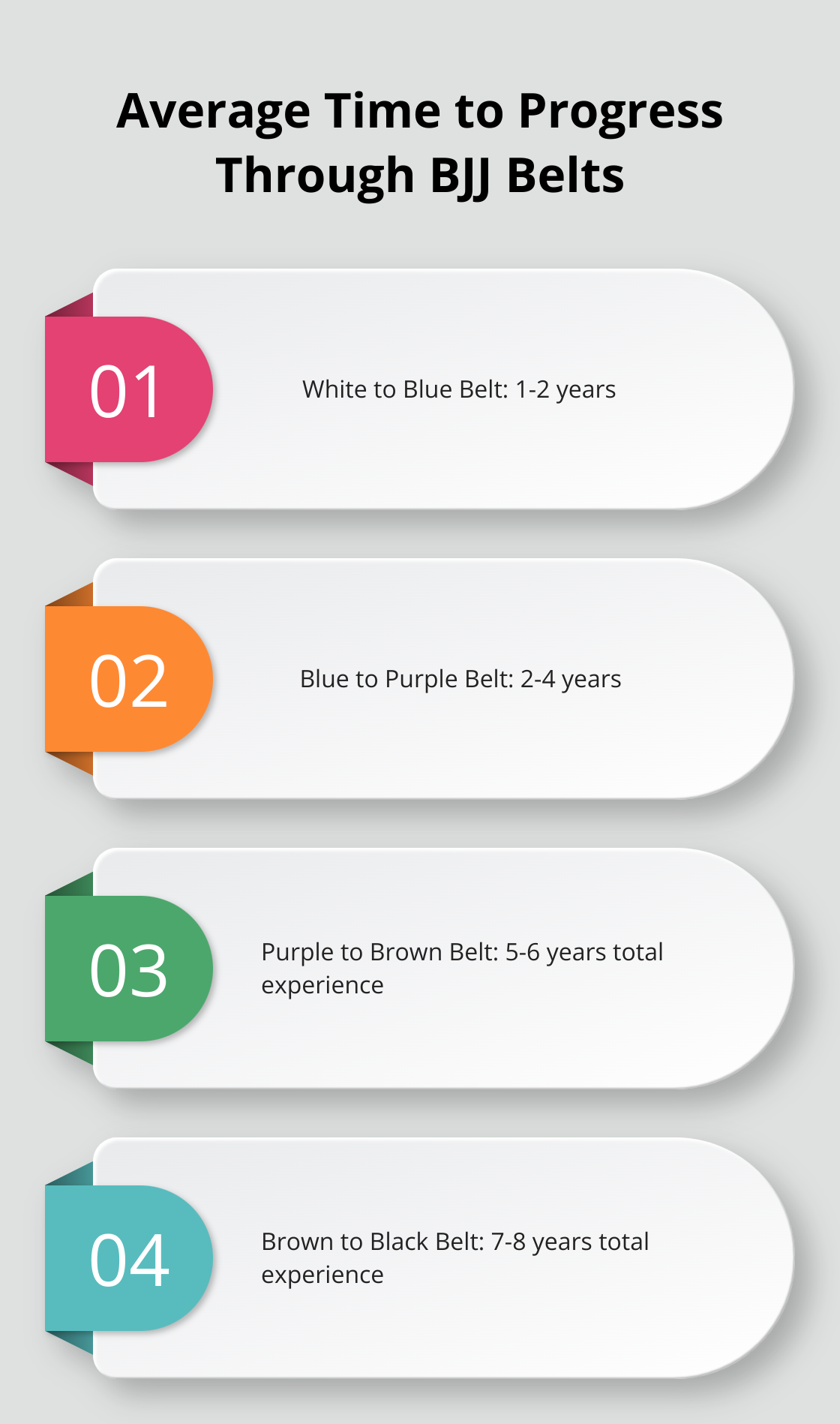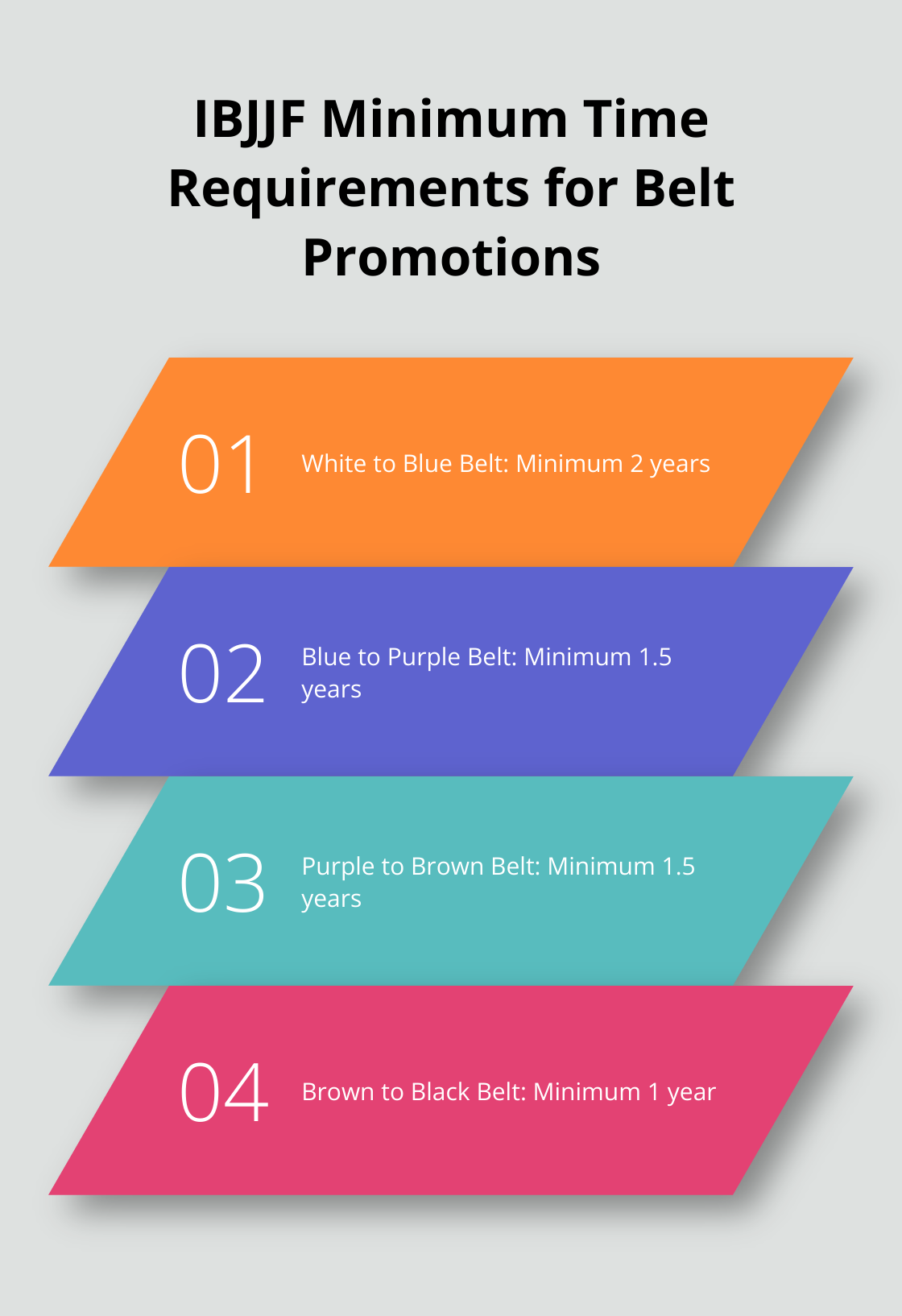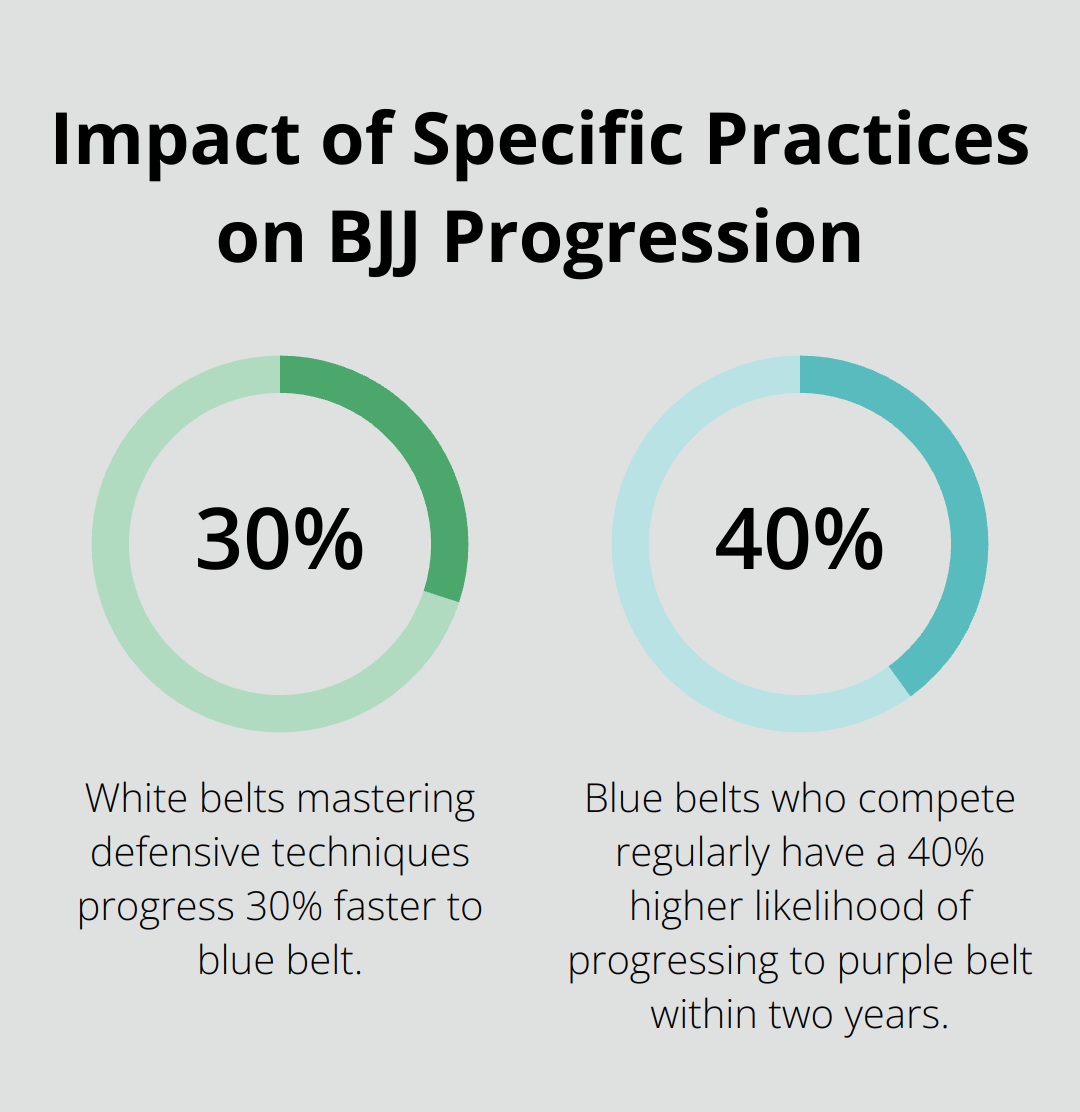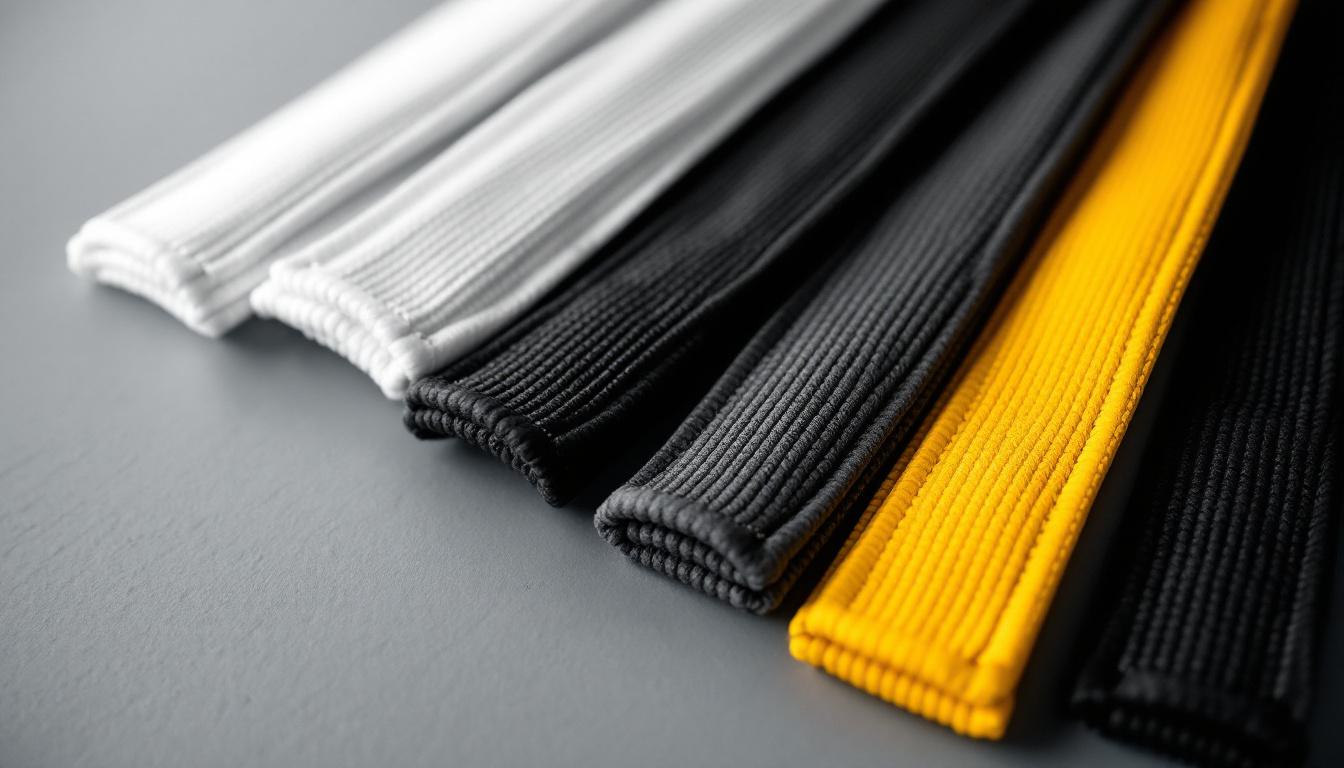At Jiu Jitsu, we often get asked about the journey through the ranks. The belt system is a fundamental aspect of Brazilian Jiu-Jitsu, representing a practitioner’s skill level and dedication to the art.
In this post, we’ll break down the Jiu-Jitsu belts, from white to black, and explore what it takes to progress through each level. We’ll also discuss the factors that influence belt promotions and why focusing on personal growth is more important than chasing colors.
What Are the Jiu-Jitsu Belt Colors?
The belt system in Brazilian jiu-jitsu signifies a practitioner’s increasing level of technical knowledge and practical skill within the art. At Souza Grappling Co., we follow the traditional BJJ belt hierarchy, which consists of five main adult belts: white, blue, purple, brown, and black.

White Belt: The Beginning of the Journey
The white belt marks the starting point for all BJJ practitioners. This phase involves discovery and learning fundamental techniques. On average, it takes about 1-2 years of consistent training to progress from white to blue belt. During this time, students focus on basic positions, escapes, and submissions.
Blue Belt: Building a Solid Foundation
Blue belt is where many practitioners start to develop their own style. This rank typically takes 2-4 years to achieve. Blue belts must have a good understanding of most positions and execute basic techniques effectively. The International Brazilian Jiu-Jitsu Federation (IBJJF) sets a minimum of two years at white belt before promotion to blue.
Purple Belt: Refining Techniques and Strategy
Purple belt often represents the middle ground of BJJ progression. Practitioners at this level usually have 5-6 years of experience. They must have a deep understanding of BJJ principles and teach lower belts. The IBJJF requires a minimum of 1.5 years at blue belt before promotion to purple.
Brown Belt: Advanced Skills and Teaching
Brown belt signifies advanced proficiency in BJJ. It typically takes 7-8 years of dedicated training to reach this level. Brown belts often involve themselves in teaching and develop their own unique style of grappling. The IBJJF mandates at least 1.5 years at purple belt before promotion to brown.
Black Belt: Mastery and Beyond
The black belt represents the ultimate goal for many BJJ practitioners. It usually takes 10-15 years of consistent training to achieve this rank. Black belts are considered experts in the art and often take on significant teaching roles. The IBJJF requires a minimum of 1 year at brown belt before promotion to black.
It’s important to note that these timeframes are averages, and individual progression can vary significantly. Factors such as training frequency, natural aptitude, and competition experience can all influence the speed of advancement through the ranks.
At Souza Grappling Co., we emphasize the journey’s importance over the destination. While belt promotions mark exciting milestones, the real value lies in personal growth, improved fitness, and self-defense skills gained along the way.
Now that we’ve explored the belt colors and their significance, let’s examine the specific techniques and skills associated with each belt level in the next section.
Skills and Techniques at Each Belt Level
White Belt: Laying the Groundwork
White belts focus on survival skills and basic positions. They learn fundamental techniques such as shrimping, bridging, and proper hip movement. White belts also familiarize themselves with core positions (guard, side control, and mount). The emphasis at this stage rests on defense and escapes. A study by the BJJ Research Institute reveals that white belts who master defensive techniques progress 30% faster to blue belt.
Blue Belt: Broadening the Skill Set
Blue belts refine their techniques and start to develop their own style. They learn more advanced submissions and begin to understand how to chain moves together. Blue belts also improve their guard passing and sweeps. Participation in local competitions helps blue belts test their skills. Statistics indicate that blue belts who compete regularly have a 40% higher likelihood of progressing to purple belt within two years.
Purple Belt: Developing Strategy and Flow
Purple belts gain a deeper understanding of BJJ strategy. They learn to anticipate opponents’ moves and create effective counter-strategies. Purple belts also work on improving their timing and flow during rolls. They start to specialize in certain positions or submissions, developing their signature moves. Brazilian jiu-jitsu and grappling arts serve as an authoritative guide for martial artists at this level.
Brown Belt: Advanced Techniques and Teaching
Brown belts demonstrate advanced proficiency in BJJ. They often take on teaching roles, which helps solidify their knowledge. Brown belts develop a unique style of grappling and focus on refining their techniques to a high level of efficiency. They also work on developing counters to common techniques and understanding weight distribution in top positions.
Black Belt: Mastery and Innovation
Black belts represent the pinnacle of BJJ skill. They showcase a deep understanding of the art, demonstrating efficiency and effectiveness in their techniques. Black belts continue to refine their skills, often focusing on the subtleties of basic movements. They also play a significant role in teaching and mentoring lower belts, contributing to the growth of the BJJ community.
The journey through these belt levels requires dedication, consistency, and a willingness to learn. As practitioners progress, they not only improve their technical skills but also develop mental resilience and problem-solving abilities. The next section will explore the factors that influence belt progression in BJJ.

What Drives Belt Progression in BJJ?
Consistency: The Foundation of Progress
Regular training forms the bedrock of advancement in Brazilian Jiu-Jitsu. Studies have shown that BJJ training can significantly reduce stress and anxiety while boosting self-esteem and self-efficacy in adults. This consistency enhances technique retention and provides more opportunities to apply skills during live rolling sessions.
Competition: Putting Skills to the Test
While not mandatory, competition experience can accelerate belt progression. Tournaments offer a platform to test skills under pressure, expose weaknesses, and build mental toughness.

Attitude and Dedication: The Mental Edge
A positive attitude and unwavering dedication significantly impact progression. Instructors often look for students who demonstrate a willingness to learn, help others, and contribute to the gym’s culture.
Instructor Evaluation: The Final Say
Belt promotions ultimately fall under the discretion of qualified instructors. They assess not just technical proficiency, but also a student’s overall growth, ability to apply techniques in live rolling, and adherence to BJJ principles. Some academies use formal testing, while others rely on continuous assessment.
Holistic Approach to Progression
At Souza Grappling Co., we emphasize a comprehensive approach to belt progression. We encourage our students to focus on consistent training, participate in competitions when ready, maintain a positive attitude, and trust the evaluation process. Each day on the mat presents an opportunity for growth (regardless of belt color).
Final Thoughts
The journey through Jiu-Jitsu belts offers more value than the destination itself. Patience and continuous learning form the foundation of success in Brazilian Jiu-Jitsu. Every class, roll, and challenge presents an opportunity for growth, regardless of your belt color.
Belt promotions mark significant milestones, but they shouldn’t become the sole focus of your training. The true essence of Jiu-Jitsu lies in personal development, improved technique, mental resilience, and a supportive community. These aspects contribute far more to your overall growth than the pursuit of the next belt color.
We invite you to embrace your Jiu-Jitsu journey at Souza Grappling Co.. Our facility and instructors provide an environment for you to grow in your Jiu-Jitsu practice (from white belt to black and beyond). Step onto the mat with an open mind and enjoy the process of mastering this transformative martial art.




